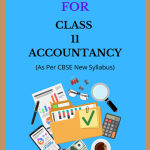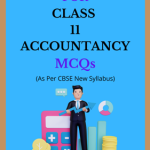NCERT Class 11 Accountancy MCQ Chapter 8 Financial Statements-I Solutions, AHSEC Class 11 Accountancy Multiple Choice Question Answer to each chapter is provided in the list so that you can easily browse throughout different chapters NCERT Class 11 Accountancy MCQ Chapter 8 Financial Statements-I Question Answer and select needs one.
NCERT Class 11 Accountancy MCQ Chapter 8 Financial Statements-I
Also, you can read the AHSEC book online in these sections NCERT Class 11 Accountancy Multiple Choice Solutions by Expert Teachers as per AHSEC (CBSE) Book guidelines. AHSEC Class 11 Accountancy MCQ Solutions. These solutions are part of CBSE All Subject Solutions. Here we have given HS 1st Year Accountancy Objective Type Question Answer for All Subjects, You can practice these here.
Financial Statements-I
Chapter: 8
| PART – ⅠⅠ |
MULTIPLE CHOICE QUESTION ANSWER
1. Financial statements are primarily prepared to meet the information needs of:
(i) Internal stakeholders only.
(ii) External stakeholders only.
(iii) Both internal and external stakeholders.
(iv) Government agencies only.
Ans: (iii) Both internal and external stakeholders.
2. Management accounting helps in making decisions related to:
(i) Product pricing.
(ii) Market entry.
(iii) Resource allocation.
(iv) All of the above.
Ans: (iv) All of the above.
3. Which of the following describes a monetary stake in a business?
(i) Government’s regulatory role.
(ii) A researcher’s interest in business data.
(iii) An owner’s investment.
(iv) Customer’s brand loyalty.
Ans: (iii) An owner’s investment.
4. Which of the following statements best describes the information requirement of managers?
(i) They require information to fulfil tax obligations.
(ii) They need accounting information for career progression.
(iii) They need financial statements as a report card.
(iv) They act as agents of owners and require accounting information to make business decisions.
Ans: (iv) They act as agents of owners and require accounting information to make business decisions.
5. Recording of the business transaction in a systematic way is called:
(i) Accounting.
(ii) Recording.
(iii) Journalizing.
(iv) Bookkeeping.
Ans: (iv) Bookkeeping.
6. Which of the following is an internal user of accounting information?
(i) Government.
(ii) Bank.
(iii) Manager.
(iv) Prospective owner.
Ans: (iii) Manager.
7. If the total expenses are Rs. 50,000 and total revenues are Rs.70,000, what is the net profit?
(i) Rs.20,000
(ii) Rs.1,20,000
(iii) Rs.70,000
(iv) Rs.0
Ans: (i) Rs.20,000
8. A company has total liabilities of Rs. 500,000 and equity of Rs.300,000. What is the debt-to-equity ratio?
(i) 1.67
(ii) 1.25
(iii) 0.5
(iv) 0.75
Ans: (i) 1.67
9. Which of the following statements best describes capital items?
(i) They are day-to-day expenses for the business.
(ii) They are used to prepare the trading and profit and loss account.
(iii) They are related to long-term assets or investments.
(iv) They only include cash transactions.
Ans: (iii) They are related to long-term assets or investments.
10. Which of the following would typically be classified as a capital expenditure?
(i) Payment of utility bills.
(ii) Interest on bank loan.
(iii) Purchase of office equipment.
(iv) Advertising expenses.
Ans: (iii) Purchase of office equipment.
11. If a company has an inventory turnover ratio of 8 and its average inventory is Rs. 50,000, what are the cost of goods sold?
(i) Rs.400,000
(ii) Rs.500,000
(iii) Rs.600,000
(iv) Rs.700,000
Ans: (i) Rs.400,000
12. Which of the following is NOT a revenue item?
(i) Depreciation expense.
(ii) Sales revenue.
(iii) Purchase of furniture.
(iv) Wages paid.
Ans: (iii) Purchase of furniture.
13. What type of expenditure is salaries paid to employees?
(i) Capital expenditure.
(ii) Revenue expenditure.
(iii) Deferred expenditure.
(iv) None of the above.
Ans: (ii) Revenue expenditure.
14. If a company has sales of Rs.1,000,000 and a cost of goods sold of Rs.600,000, what is the gross profit?
(i) Rs.400,000
(ii) Rs.600,000
(iii) Rs.1,600,000
(iv) Rs.0
Ans: (i) Rs.400,000
15. Which of the following items is included in the adjustment of net income to obtain cash flow from operating activities?
(i) Depreciation expense for the period.
(ii) The change in deferred taxes.
(iii) The amount by which equity income recognized exceeds cash received.
(iv) All of the above.
Ans: (iv) All of the above.

Hi! my Name is Parimal Roy. I have completed my Bachelor’s degree in Philosophy (B.A.) from Silapathar General College. Currently, I am working as an HR Manager at Dev Library. It is a website that provides study materials for students from Class 3 to 12, including SCERT and NCERT notes. It also offers resources for BA, B.Com, B.Sc, and Computer Science, along with postgraduate notes. Besides study materials, the website has novels, eBooks, health and finance articles, biographies, quotes, and more.





